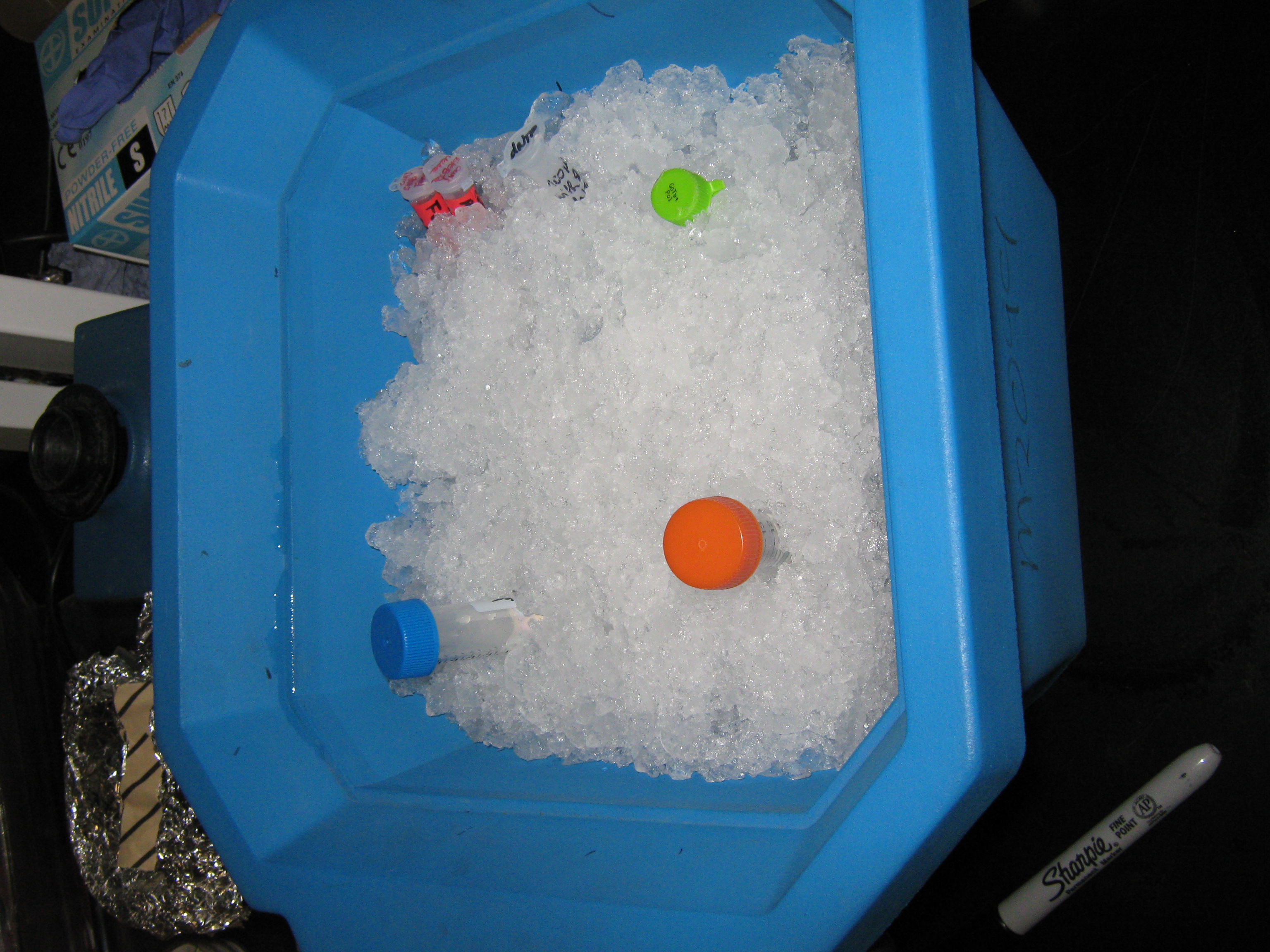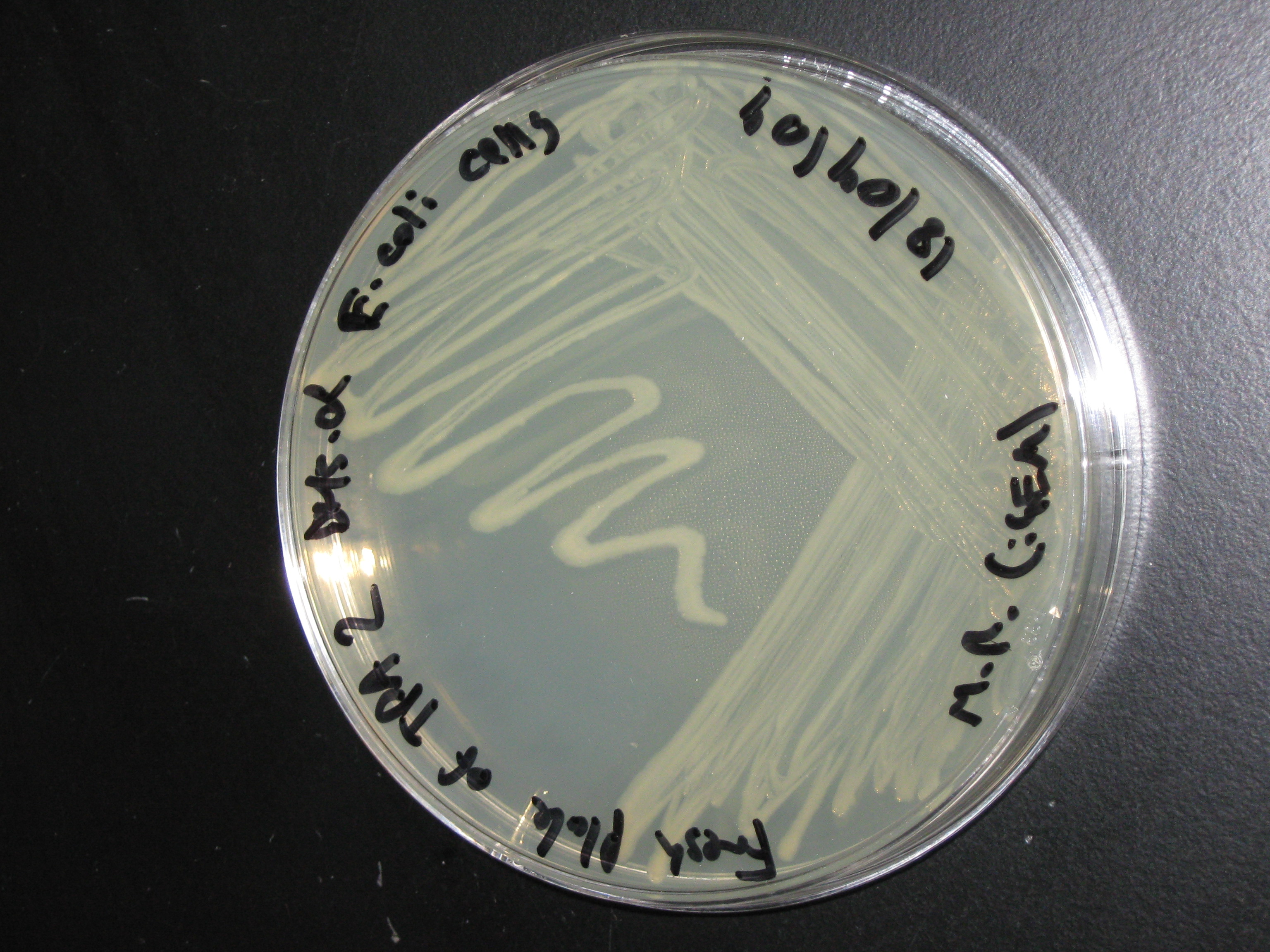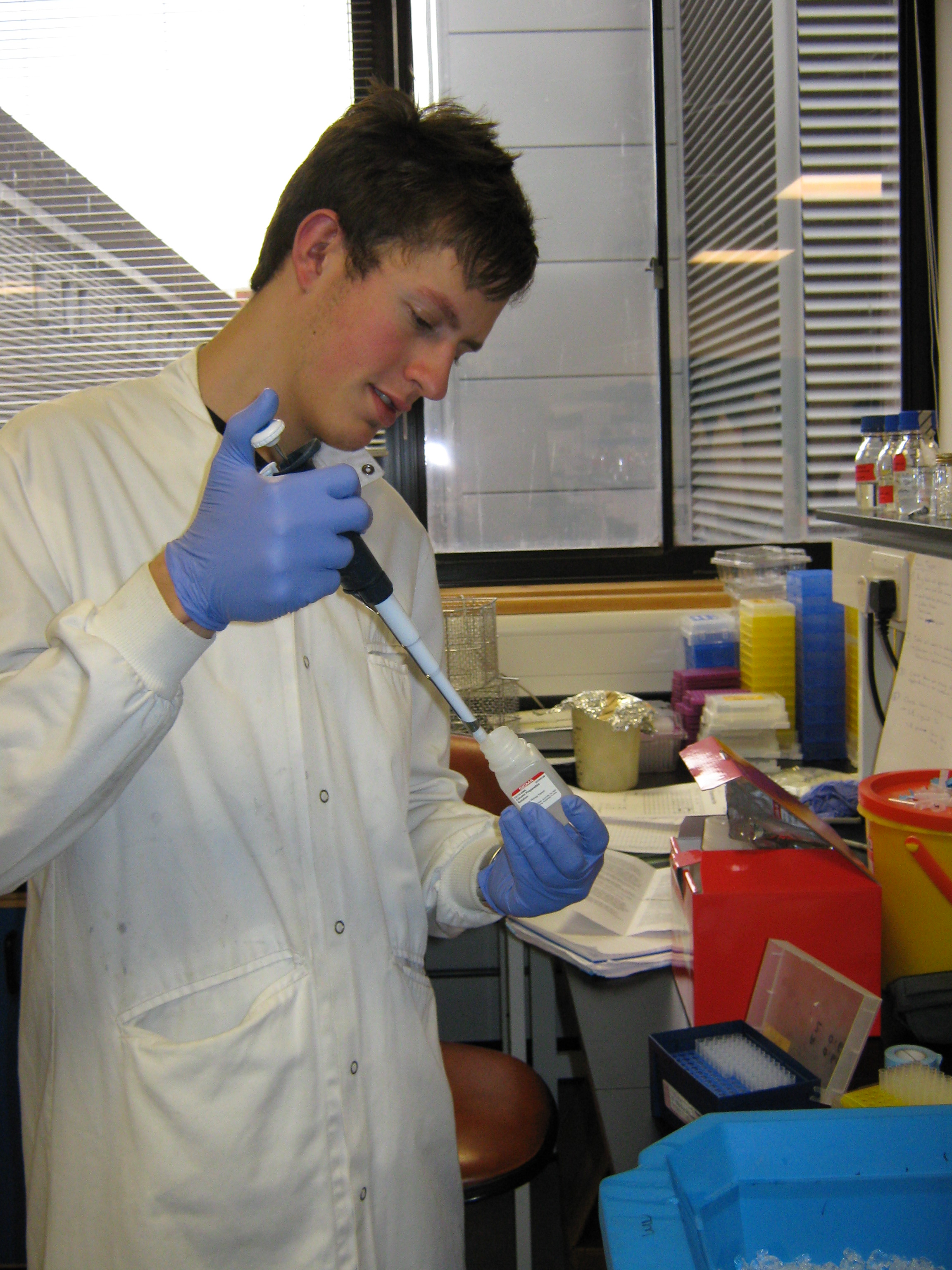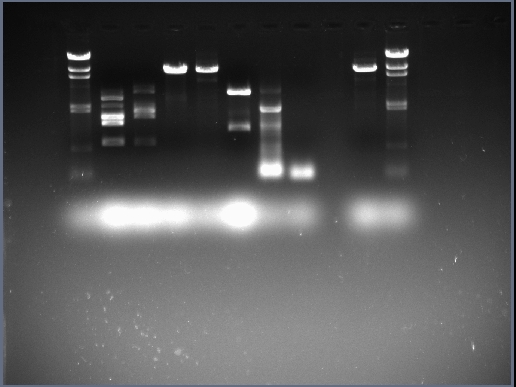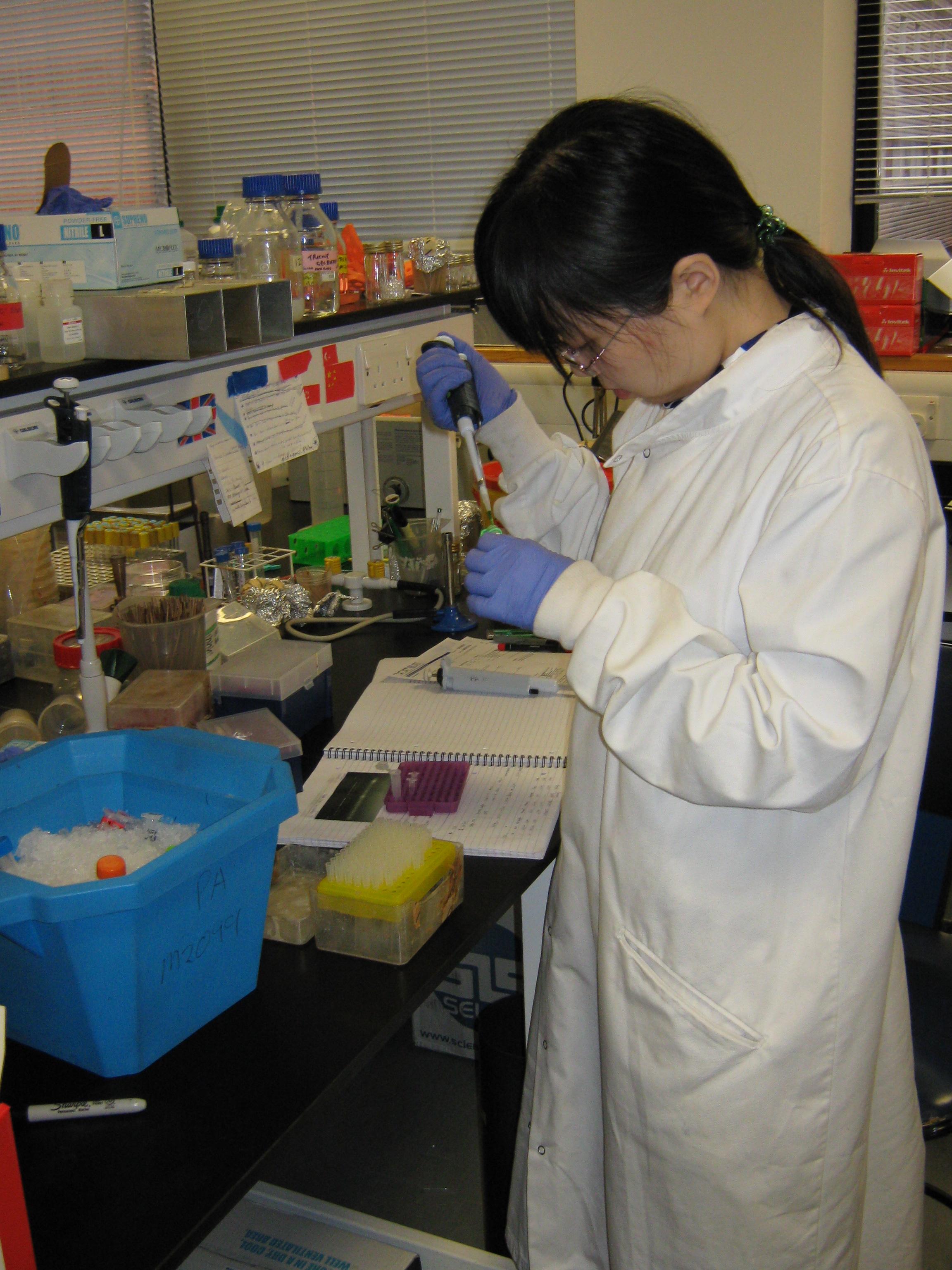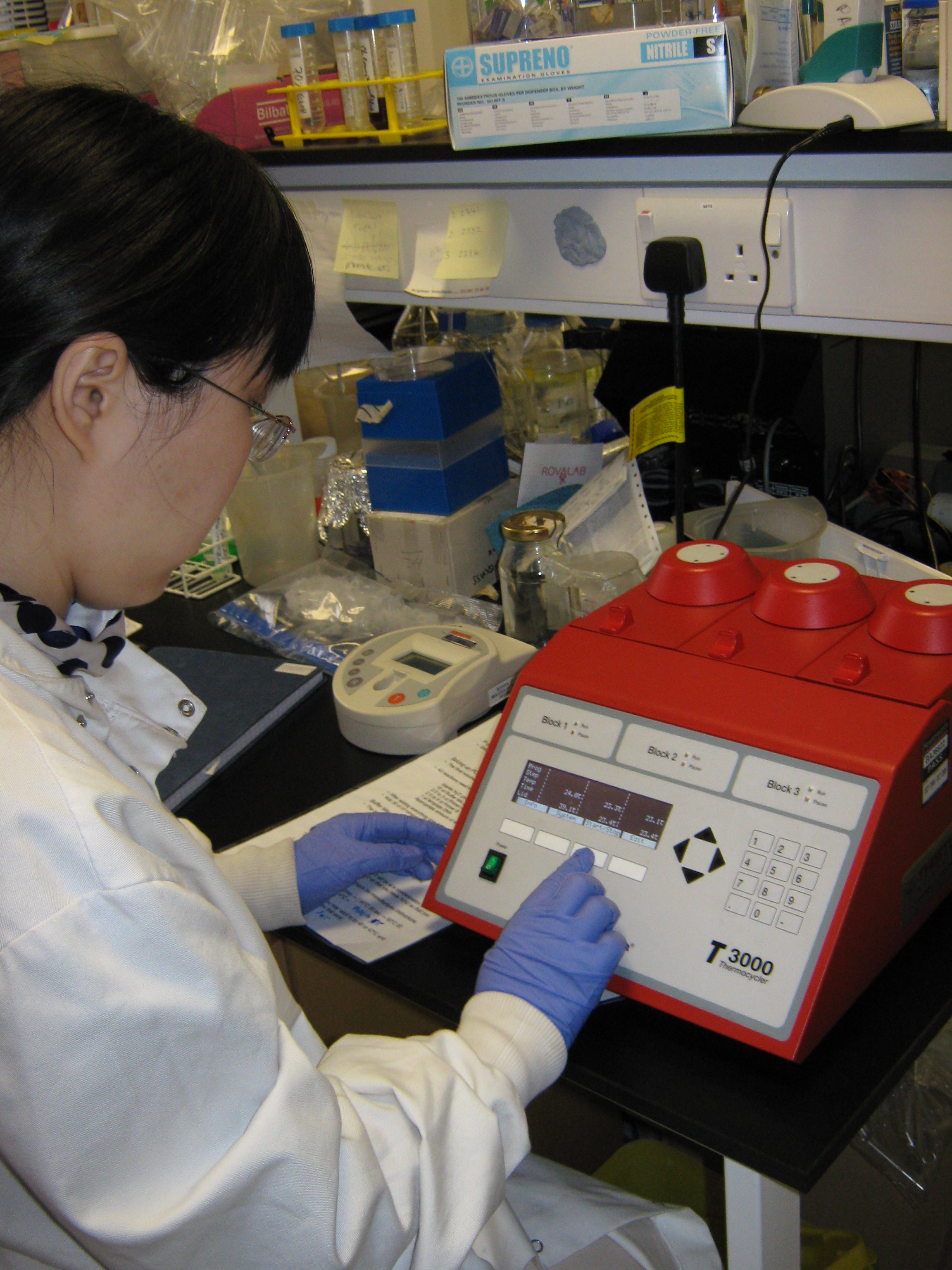Team:Newcastle/Labwork/21 September 2009
From 2009.igem.org
(→Excising digested pMUTIN4 from gel) |
(→Quantification of cotC and pMUTIN4) |
||
| (One intermediate revision not shown) | |||
| Line 59: | Line 59: | ||
====Analysing midi-prep digests==== | ====Analysing midi-prep digests==== | ||
[[Image:Team Newcastle 2009 iGEM Geldoc 2009-09-21 13hr 11min.jpg|400px|center]] | [[Image:Team Newcastle 2009 iGEM Geldoc 2009-09-21 13hr 11min.jpg|400px|center]] | ||
| + | <br> | ||
| + | * Lane 1 = blank | ||
| + | * Lane 2 = DNA HindIII ladder | ||
| + | * Lane 3 = ''cotC'' midi-prep digest | ||
| + | * Lane 4 = ''kinA'' midi-prep digest | ||
| + | * Lane 5 = ''pGFP-rrnB'' midi-prep digest | ||
| + | * Lane 6 = ''pMUTIN4'' midi-prep digest | ||
| + | * Lane 7 = ''pSB1AT3'' midi-prep digest. | ||
| + | * Lane 8 = PCR reaction 1 | ||
| + | * Lane 9 = PCR reaction 2 | ||
| + | * Lane 10 = blank | ||
| + | * Lane 11 = ''pMUTIN4'' double digest (10ul) | ||
| + | * Lane 12 = DNA HindIII ladder | ||
| + | <br> | ||
| + | |||
====Double digesting ''pMUTIN4'' midi-prep DNA==== | ====Double digesting ''pMUTIN4'' midi-prep DNA==== | ||
Double digest of 10ul of ''pMUTIN4'' DNA was conducted in the following manner: | Double digest of 10ul of ''pMUTIN4'' DNA was conducted in the following manner: | ||
| Line 89: | Line 104: | ||
====Quantification of ''cotC'' and ''pMUTIN4''==== | ====Quantification of ''cotC'' and ''pMUTIN4''==== | ||
| - | + | ''cotC'' = 26.6ng/ul | |
| + | ''pMUTIN4'' = 23.6ng/ul | ||
<br> | <br> | ||
| + | |||
==<u>Sporulation Tuning/Chassis Team</u>== | ==<u>Sporulation Tuning/Chassis Team</u>== | ||
[[Image:Team Newcastle 2009 iGEM 21-09-09 IMG 1275.JPG|200px|right]] | [[Image:Team Newcastle 2009 iGEM 21-09-09 IMG 1275.JPG|200px|right]] | ||
Latest revision as of 03:30, 22 October 2009
Formal Lab Session - 21st September 2009
Overview
Stochastic Switch Team
Today we digested the sac minipreps with EcoRI and XbaI. It seems clear that there was something wrong with the minipreps (such as poor procedure) as there seemed to be little or no DNA in the sample.
Did a gel fragment clean up on the sspb fragment cut from the gel, this was put in the 'fragments' box in the freezer ready for later.
50ul of ara+pSB1AT3 plasmid was cut with SpeI and PstI in order to insert the sspb fragment after the operator. Rather than doing a gel fragment prep a PCR clean up (kit) was done on the digest to save time.
We ligated the ara + sspb fragments using Chris' method:
- 2ul Ligase buffer
- 2.5ul Vector DNA
- 14.5ul insert DNA
- 1ul ligase
= 20ul
This was left in the fridge overnight to improve the ligation conditions.
Metal Sensor Team
Introduction
Practical Outline
Here are the list of tasks which need to be accomplished by the end of the day:
- Run analysis digests of the 5 midi-preps of cotC, kinA, pGFP-rrnB, pMUTIN4 and pSB1AT3 (midi-prepped in the 11/09/09 lab session and digested in the 18/09/09 lab session)
- If successful, double digest 40ul of pMUTIN4 with BamHI and HindIII and place under DNA gel electrophoresis; excise band produced and extract DNA
- If unsuccessful, inoculate 5ml of LB with E. coli containing pMUTIN4 (for mini-preps and midi-preps)
- Check PCR reaction (amplification of cotC-GFP-smtA) on gel and clean up if successful
- If successful, digest with BamHI and HindIII
- Should the pMUTIN4 DNA extraction be a success and the cotC-GFP-smtA BioBrick be successfully amplified (by PCR) and extracted, ligate the two fragments together.
- Reactions include:
- vector + insert + ligase
- vector + ligase
- vector and NO ligase
- Reactions include:
- Inoculate 3ml of LB with TPA2 cells (for production of competent DH5-alpha E. coli cells)
Procedure
Analysing midi-prep digests
- Lane 1 = blank
- Lane 2 = DNA HindIII ladder
- Lane 3 = cotC midi-prep digest
- Lane 4 = kinA midi-prep digest
- Lane 5 = pGFP-rrnB midi-prep digest
- Lane 6 = pMUTIN4 midi-prep digest
- Lane 7 = pSB1AT3 midi-prep digest.
- Lane 8 = PCR reaction 1
- Lane 9 = PCR reaction 2
- Lane 10 = blank
- Lane 11 = pMUTIN4 double digest (10ul)
- Lane 12 = DNA HindIII ladder
Double digesting pMUTIN4 midi-prep DNA
Double digest of 10ul of pMUTIN4 DNA was conducted in the following manner:
- 10ul of pMUTIN4 DNA
- 1ul of FastDigest BamHI
- 1ul of FastDigest HindIII
- 2ul of restriction buffer
- 6ul of sterile distilled water
The digests were allowed to commence for 1 hour under 37C incubation. Samples of this digest were then analysed through DNA gel electrophoresis and can be seen in the GelDoc photograph above.
Cleaning up cotC PCR product
The cotC_GFP_smtA BioBrick was cleaned up using GenElute's PCR clean-up kit and it's protocol was adhered to.
Excising digested pMUTIN4 from gel
Firstly 40ul of pMUTIN4 was digested using BamHI and HindIII in the following manner:
- 40ul of pMUTIN4 DNA
- 4ul of FastDigestBamHI
- 4ul of FastDigestHindIII
- 8ul of buffer
- 24ul of sterile distilled water
Incubated for 1 hour under 37C in waterbath. DNA was then all placed into agarose gel and DNA gel electrophoresis was allowed to commence for 20 minutes under 70 volts. Band was excised and cleaned up
Band weighed 0.351 grams so the amount of gel solubilization solution used was 1053ul.
Quantification of cotC and pMUTIN4
cotC = 26.6ng/ul
pMUTIN4 = 23.6ng/ul
Sporulation Tuning/Chassis Team
Introduction
- We have already got the double clone,the next thing need to do is to ligate this sleB:cwlJ fragment with pMutin4 plasmid to get the pspac sequence from pMutin4. pMutin4 contains HindIII and BamHI restriction sites, but our double clone sequence didn't contain those sites. If we want to ligate double clone fragment with pMutin4 backbone, we need PCR our double clone fragment and add HindIII and BamHI restriction sites.We designed cwlJsleB primers here.
- We digest pMutin4 with HindIII and BamHI to get our plasmid backbone.
- Midi Prep L1 and L2 transformation strains to get large amount of plasmid.
- Our kinA synthesized part was arrived, we need to construct this gene into our integrate plasmid and transform it into B.subtilis.
Experiment procedure
PCR doulbe clone fragment
- Prepare buffer mix and Taq
Reaction buffer 10ul x 4 = 40ul
dNTP 2ul x 4 = 8ul
--------------------------------
48ul
12ul for each reaction
GoTaq(5U/ul) 0.25ul x 2 = 0.5ul
ddH2O 4.5ul
----------------------------------
5ul
2.5ul for each reaction
| No. | Water (ul) | PCR Mix (ul) | Forward Primer (ul) | Reverse Primer (ul) | Template (ul) | Polymerase used (ul) | Total Volume (ul) |
|---|---|---|---|---|---|---|---|
| 1 | 28.5 | 12 | cwlJsleBForward 2.5ul | cwlJsleBReverse 2.5ul | pSB1AT3:cwlJ:sleB 2ul | GoTaq 2.5ul | 50 |
| 2 | 30.5 | 12 | cwlJsleBForward 2.5ul | cwlJsleBReverse 2.5ul | 0ul | GoTaq 2.5ul | 50 |
- PCR procedure: STD50
95C 2min -->[95C 30S --> 50C 30S --> 75C 1min] 30 runs --> 75C 5min --> store at 4C
Prepare for Midi Prep
- Add 50ml LB+Amp+Tet liquid medium into a flask, get 200ul cell mixture from Mini prep culture.
- Culture L1 and L2 overnight.
Digest pMutin4 plasmid for ligation
- Prepare the digest reaction.
dd H2O 7ul
10X fast digest buffer 7ul
Fast HindIII 3ul
Fast BamHI 3ul
pMutin4 plasmid 50ul
------------------------------
70ul
- Incubate 1 hour at 37 degree.
Digest kinA fragment
- Digest pMK-RQ vector to get kinA fragment.(Jess has done this part)
- Run big well gel to seperate kinA and pMK-RQ backbone.
- Use gel extraction kit to purify kinA fragment.
Conclusion
- When we cut pMK-RQ with EcoRI and NheI, both pMK-RQ back bone and kinA fragment are about 2k bp. To get the purified kinA fragment, we need to run the gel for a longer time to seperate the two bands. The other way is to introduce the third enzyme which can cut the backbone into 2 pieces and keep kinA's integrability.
Futher plan
- Ligate kinA with pGFP-rrnB.
- Ligate cwlJ:sleB fragment with pMutin4 and transform ligated plasmid into E.coli.
|
| |||||||||||||||||||||||||||||||||||||||||||||||||||||||||||||||||||||||||||||||||||||||||||||||||
|
| |||||||||||||||||||||||||||||||||||||||||||||||||||||||||||||||||||||||||||||||||||||||||||||
News
Events
- 20 – 21 June 2009 - Europe workshop (London)
- 23 – 24 June 2009 - UK iGEM meetup (Edinburgh)
- 23 October Practice Presentation (Newcastle)
- 23 October T-shirts are ready
- 27 October Practice Presentation (Sunderland)
- 27 October Poster is ready
- 30 October – 2 November 2009 - Jamboree (Boston)
Social Net
- Newcastle iGEM Twitter
- [http://www.facebook.com/home.php#/group.php?gid=131709337641 Newcastle on Facebook]
- [http://www.youtube.com/user/newcastle2009igem Newcastle Youtube Channel]
 "
"

